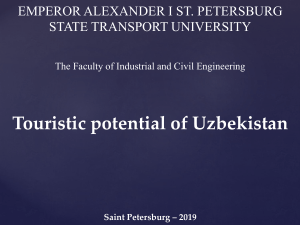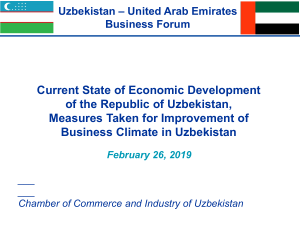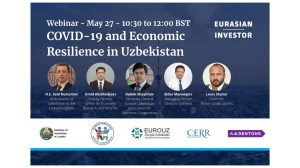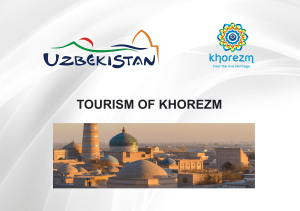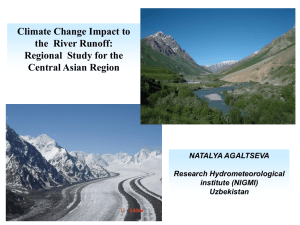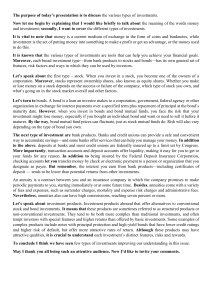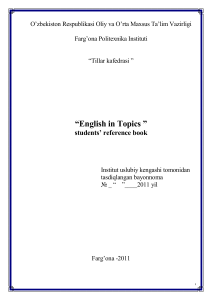II. Dynamics and structure of foreign investments in Uzbekistan
advertisement
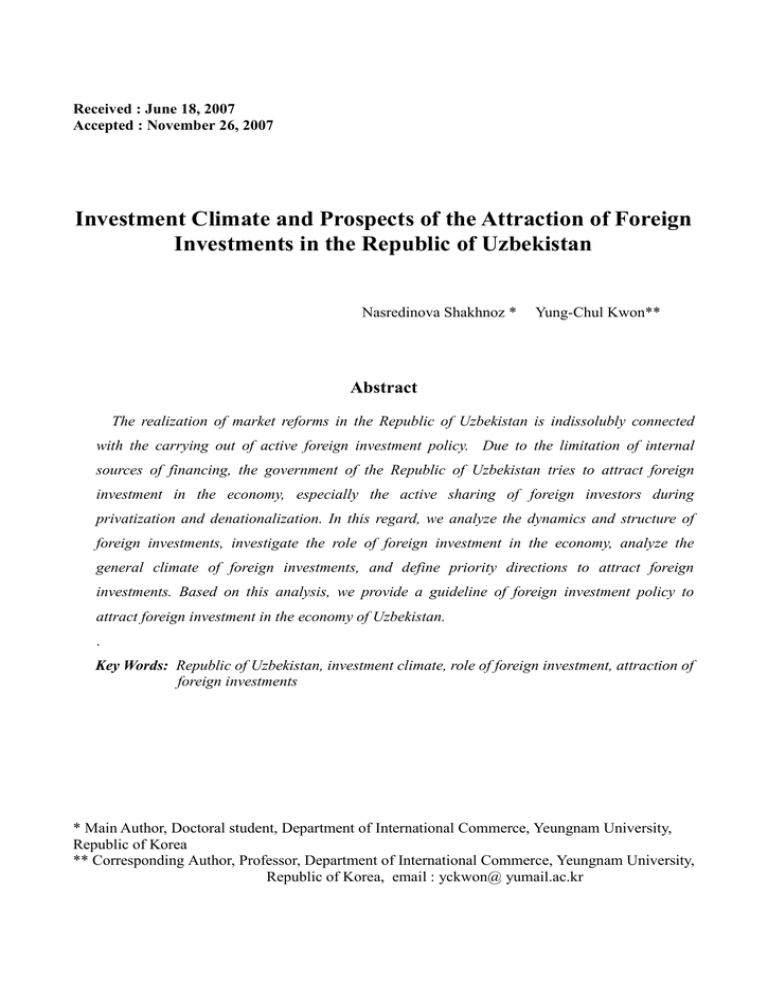
Received : June 18, 2007 Accepted : November 26, 2007 Investment Climate and Prospects of the Attraction of Foreign Investments in the Republic of Uzbekistan Nasredinova Shakhnoz * Yung-Chul Kwon** Abstract The realization of market reforms in the Republic of Uzbekistan is indissolubly connected with the carrying out of active foreign investment policy. Due to the limitation of internal sources of financing, the government of the Republic of Uzbekistan tries to attract foreign investment in the economy, especially the active sharing of foreign investors during privatization and denationalization. In this regard, we analyze the dynamics and structure of foreign investments, investigate the role of foreign investment in the economy, analyze the general climate of foreign investments, and define priority directions to attract foreign investments. Based on this analysis, we provide a guideline of foreign investment policy to attract foreign investment in the economy of Uzbekistan. . Key Words: Republic of Uzbekistan, investment climate, role of foreign investment, attraction of foreign investments * Main Author, Doctoral student, Department of International Commerce, Yeungnam University, Republic of Korea ** Corresponding Author, Professor, Department of International Commerce, Yeungnam University, Republic of Korea, email : yckwon@ yumail.ac.kr I. Introduction «..it is necessary to create even more favorable legislative conditions, guarantees and economic stimulus for wide attraction of foreign investments into a national economy, first of all direct investments. It is necessary to achieve, that foreign investments actively participated in structural transformations of our economy, acceleration of technology and modernization of manufacture»1 I.A. Karimov In the modern world, few countries remain that have not been involved in the processes of international investment cooperation. Stable economic development is impossible without the active use of the advantages of attracting investments from abroad. Recently, the international movement of capital has been facilitated. The unified norms of state regulation of investment processes have been widely circulated for the last decade. They are contained in bilateral agreements on the protection and encouragement of investments and multilateral arrangements acting within the limits of international economic organizations, in particular, the World Trade Organization. Successful integration of countries with transitive market economies into the global economic community is impossible without the formation of a corresponding investment climate and active attraction of foreign investment into the national economies. Uzbekistan, as well as other countries, is interested in actively sharing in the processes of international cooperation by means of international integration and a division of labor. The subject of special and constant attention of the government of the Republic of Uzbekistan is the perfection of an investment climate and creation of favorable conditions to attract foreign investments in the republic’s economy, active sharing of foreign investors during privatization and denationalization, and to produce competitive products for the international markets. Under the conditions of limited internal sources of financing, attracting foreign capital in the republic’s economy becomes very important. Attraction and effective use of foreign investments in the republic’s economy is one of the major directions of mutually advantageous economic complementation of Uzbekistan with foreign countries. Attraction of foreign investment plays an important role in the economic development of any state, as productive forces of a republic require large investments for modernization and reconstruction, development of potential exports, and insufficient internal sources of financing. In Доклад Президента Республики Узбекистан И. А. Каримова на первой сессии Олий Мажлиса Республики Узбекистан второго созыва. «Народное слово», 23 января 2000 г. 1 2 Uzbekistan, which has led the formation of a market economy, there are a number of priority problems in reforming the open economy, integrating it into the global economy, and using the advantages of the international division of labor. Therefore, attracting large-scale foreign investment is one of the major directions of policy conducted by the state. The main purpose of this research is the development of recommendations for attracting foreign investments by the Republic of Uzbekistan. To understand this issue the following questions must be examined: Analysis of the dynamics and structure of foreign investments. Analysis of the general climate of foreign investment. Analysis of the priority directions to attract foreign investment. The proposed framework, therefore, consists of six integral parts. Following the first part or the introduction, the second part analyzes the current status of foreign investment, and the third part investigates the investment climate of the country. In the fourth part, we suggest a policy to attract foreign investment in Uzbekistan’s economy, and the fifth and final part includes the summary and conclusions II. DYNAMICS AND STRUCTURE OF FOREIGN INVESTMENTS IN UZBEKISTAN In terms of accommodation, foreign investments are divided into the short-term (up to 3 to 4 years), intermediate term (from 4 to 10 years), and long-term (10 to 15 years). Foreign investments are also divided into direct and portfolio. Foreign direct investments (FDIs) establish an effective control and entitling of the direct order above the foreign company. By definition of the IMF, FDIs are of the case when the foreign proprietor possesses not less than 25% of the authorized capital of a joint-stock company. On the other hand, portfolio investments are capital investments that share in the capital of firms below a limit designated for direct investments. Portfolio investments do not provide control over foreign companies, limiting the prerogatives of the investor to a share of the profits and dividends. 2.1. Foreign Investments by Volume 3 <Figure 1> Dynamics of Foreign Investments in the Economy of Uzbekistan $ mln 400 350 300 250 200 150 100 50 0 d 94 995 996 997 998 999 000 001 002 003 004 005 cte 9 1 1 1 1 1 1 2 2 2 2 2 2 di e pr 6 0 20 years Source: The State Statistics Committee of Uzbekistan and World Bank Indicators, 2005. We can see the dynamics of foreign investments in Uzbekistan over the past ten years in Figure 1. From 1994, with more than $50 million, until 1998, with $260 million, respectively, foreign investment increased.2 In the beginning stages, foreign investors properly learned Uzbekistan’s investment climate, economic policy, and privileges for investors. The process of the real growth of foreign capital investments began in 1995. Owing to the amplified radicalism of the conducted economic reforms and the certain revival of dynamics, investment has increased considerably. As a result, 1996 was the peak period of the attraction of foreign investments with almost $350 million. But in 1999, investment attraction decreased to $130 million because of the terrorist acts in Uzbekistan. Since 1999, foreign investments have not increased as seen in 1995. This is natural for every country, at the same time for the investors, of course. But, with the opening of a converted currency in Uzbekistan, foreign investment silently began to float to Uzbekistan because it was easy for investors to operate with foreign currency. If the dynamics of foreign investment attraction is compared to that of neighboring countries, as shown in Figure 2, Uzbekistan is in a worse position after Kazakhstan, which shows almost 9 times as much3. That’s why Uzbekistan must have a better investment climate in order to reach its goal. The neighboring country of Kazakhstan’s investment climate and policy is more favorable for foreign investors than that of Uzbekistan or Tajikistan. From this figure, it is also clearly understood 2 3 Data from the State Statistics Committee of Uzbekistan and World Bank Indicators -2005 FN:CARs PSA Indicators (TAJ-KAZ-UZB), 6/10/2005 4 that in 1995, there was an inflow of foreign investors to Uzbekistan. But from 1996 until nowadays, the investors are moving to Kazakhstan. For the past 14 years, the World Bank has been posting the past scores of countries in attracting foreign investment. Counting the average parameters of these indicators shows that Uzbekistan occupies second place after Kazakhstan. Now Uzbekistan’s investment attraction score is 4, whereas Kazakhstan’s is 4.25 of a total of 7 points. In 2005 and 2006, it is predicted that Uzbekistan will have a score of 5 because of the increasing share of FDI in the total volume of exports and imports.4 <Figure 2> Comparative Indicators of Foreign Direct Investments in Uzbekistan, Kazakhstan and Tajikistan Uzbekistan Tajikistan Kazahstan 199 4 199 5 199 6 199 7 199 8 199 9 200 0 200 1 200 2 200 3 200 4 200 200 6p 5 red icte d $ mln 1400 1200 1000 800 600 400 200 0 years Source: FN:CARs PSA Indicators (TAJ-KAZ-UZB), 6/10/2005. 2.2. Foreign Investments by Country-Investors Today, investors from more than 80 countries participate in creating enterprises with foreign investments (EFI) in Uzbekistan. In 1999, the greatest number of EFIs were created by Russia (378), Turkey (243), the USA (186), and Pakistan (106).5 As we see from Figure 3, the main flow of investments was from international financial organizations (36%), Germany (18%), Great Britain (10%), and Israel (3%). But other countries, 4 5 World Development Indicators. - The World Bank, 2005. Раззакова М. Иностранные инвестиции в Узбекистане // РДК, 1999, N10, с.35 5 such as the USA, Czech Republic, Italy, and Spain, did not play a very important role in the economic development of the country. Particularly, the dynamics of investment in Uzbekistan from South Korea in the near future will total more than $1.8 billion. For the past 15 years, South Korea invested only $1 billion in the former Soviet Republic. In March 28, 2006, Uzbekistan and South Korea signed 15 documents; of which the majority were contracts concerning projects in the oil and gas and petrochemical sectors. Today, Uzbekistan and South Korea have signed 60 bilateral contracts. Commodity circulation between the countries is quickly growing. In 2005, it exceeded $564 million, an increase of 38% over 2004. In Uzbekistan, 140 enterprises operate with the participation of South Korean capital <Figure 3> Foreign Investments in 2002 by Country Investors Other countries 10% USA 4% Germany 18% Italy 3% International Financial Organizations 36% Spain 3% Austria 2% Great Britain 10% Czechia 4% Israel 10% Source: Раззакова М., Равшанов А. Иностранные инвестиции – краткий обзор // “Рынок, Деньги и Кредит”, 2002, N2, с. 59-61. 2.3. Foreign Investments by Industry Branch The decree of the president of the Republic of Uzbekistan, “On additional measures to encourage the attraction of direct private foreign investments” (dated 11.04.2005), is also aimed at improving the investment climate in the country and attracting private direct foreign investments to such priority sectors of the economy as radio electronics, light industry, silk, foodstuffs, chemical and pharmaceutical industries, and construction materials in order to increase the production and export 6 of high-quality products. One of the stimuli for this is to take steps toward the considerable reduction of the quantity of taxes for enterprises with foreign investment for a period from three to seven years depending on the volume of investment and the industrial sector. In 1999, the greatest inflow of foreign investment has been noted to the power (34%), transport (13%), agriculture (12%), and communication (10%) branches. In the first half of 2000, foreign investments were actively involved in the oil refining, chemicals, and transportation branches. The cumulative share of these branches has made more than 54%.6 An analysis of Table 1 shows that in 2004-2005, most foreign investments involved the production sector, especially in 2005, when they decreased from 90.6% to 88.7%. 7 Also in the industry sector, there were more investments in 2005 which totaled 65.3%, rather than the 37.5% as seen in 2004. In the transportation and communications and non-production sectors, sudden changes were observed during this period. But in other sectors, foreign investment was sharply decreased. <Table 1> Foreign Investments by Industry Branch (%) Source: The State Statistics Committee of Uzbekistan, 2005. 2.4. Foreign Investments by Regions Enterprises with foreign investments are placed very non-uniformly in Uzbekistan. The reason for this non-uniformity lies in the social and economic development of regions. Since 1994, foreign trade activities of all regions began to quicken noticeably in connection with the creation of the joint venture that has caused an acceleration of social and economic development and appreciable structural changes in production. Regions with rather developed infrastructure have achieved active 6 7 Сабиров Б. Структурно-инвестиционная политика Узбекистана // “РДК”, 2002, N5, с38-39 The State Statistics Committee of Uzbekistan 7 inflow and an effective utilization of investments. In 1994, foreign investment was involved in only 4 of the 14 regions. However, in 1995, all regions had foreign investment. Table 2 shows the volumes of foreign investments attracted by foreign companies during the five years of 1999-2004. Tashkent City, Fergana, Khorezm, Andijan, and Tashkent regions were more favorable and preferred by foreign investors to regions with intermediate types and an adverse investment climate. In the Navai, Bukhara, Namangan, and Kashkadarya regions, the volume of investment increased gradually due to the interests of foreign investors to such natural resources as gas and petroleum. As a result, a big consortium was created between China, South Korea, Russia, and Malaysia. The last portion of regions are Samarkand, Sirdarya, Jizzakh, and Surkhandarya. In these regions, the volume of investment is still insufficient. Most attracted investments closer to the capital city and the nearby Tashkent region. <Table 2> Foreign Investments by Volume in 1999-2004 (UZC,mln) 1. 2. 3. 4. 5. 6. 7. 8. 9. 10. 11. 12. 13. 14. Regions Republic of Karakalpakstan Andijan Bukhara Jizzakh Kashkadarya Navai Namangan Samarkand Surkhandarya Sirdarya Tashkent Fergana Khorezm Tashkent city Total 1999 97 2000 0 2001 0 2002 73 2003 85 2004 100 653 69 179 85 1174 499 3757 401 784 2250 37 1387 22775 34218 592 2223 4320 0 86 312 3091 801 419 6500 389 363 12593 31970 14555 772 13693 82 21438 27 3518 97 0 14558 27565 3312 18292 117849 10451 7104 420 4814 9816 5104 3614 141 590 10340 25678 22478 50944 164433 12176 8276 489 5608 11435 5946 4210 164 687 12047 29915 26187 59350 193562 14270 9700 573 6573 13402 6969 4934 193 805 14119 35061 30692 69558 230119 Source: The State Statistics Committee of Uzbekistan, 2005. All regions of the republic can be subdivided into three groups. First is the region with a rather favorable investment climate, with maximal activity and high rates of formation of new economic structures. It is possible to extend this group to include Tashkent City and the Tashkent, Fergana, and Kashkadarinskaya regions. Seventy six point one percent (76.1%) of all foreign investment in the economy of Uzbekistan was made in these regions. In 2001, the specific weight of these areas in the total amount of production and export of joint ventures was 69.5% and 41.5%, respectively. The second is the region of the intermediate type with a less favorable investment climate, with low activity, and average rates of economic transformations. This includes 4 regions of the republic: Bukhara, Navai, Namangan, and Samarkand. The share of the total volume of the foreign 8 investment to the regions of this group involved in the national economy was 12.7%. In 2000, the share of these areas in the total amount of production and export of joint ventures was 28.8% and 53.2%, respectively. Last is the region with an adverse investment climate, with minimum activity, and low rates of formation of new economic structures. Agricultural production prevails here, and investment projects are carried out to an insignificant degree. In 2001, the specific weight of these areas in the total amount of production and export of joint ventures was 1.8% and 5.3%, respectively. III. INVESTMENT CLIMATE AND ITS COMPONENTS Though Uzbekistan has had a successful beginning in attracting FDI, there are serious reasons for anxiety in regard to long-term success if obstacles are not quickly eliminated. Uzbekistan is a “double-locked country”, i.e., a country not having access to the sea. And it is an essential defect in a country for the development of minerals, with the purpose of their further processing and the issue of end production for export to other countries. In addition, being landlocked rather hinders the development of industries based on the processing of imported raw materials and the subsequent reexport. The republic’s dependence on other countries in the sphere of ground transport (automobile, railway, and pipeline) is also a great obstacle during the attraction of investors. In spite of the fact that Uzbekistan borrows a greater central territory in Central Asia, commercial attitudes with neighboring countries are still insufficiently developed; thereby it is hard to tell that the geographical arrangement represents itself as real advantage.8 In 2001, Fund “Heritage” published research, “The index of economic freedom on 2000,” in which the investment climate of 161 countries was evaluated by such parameters as degree of interference of the state in the economy, the level of taxation, the degree of corruption, etc. Seventythree countries were considered “economically free” or “generally free,” and 10 were considered “the economically most free.” In the category of countries having “generally not free” and “suppressed” economies were 88 countries: These countries included Eastern European states, Baltic states, and the CIS countries, including Uzbekistan.9 It is thought that not all estimations are adequate enough, but nevertheless, many investors, when choosing a country for investment, are 8 Investments Policy Review. Uzbekistan, United Nations, 1998, pp. 8-12. 9 EBRD, Transition report 1997, Economic transition in Eastern Europe and the former Soviet Union. 9 first of all guided by parameters. It is a kind of problem that is in the way of attracting foreign investment in Uzbekistan. 3.1 Foreign Exchange Regulation International experience undoubtedly shows that the countries limiting access to foreign exchange, other than the countries adhering to more liberal items, are less successful in attracting foreign investment. In 1997, the European Bank for Reconstruction and Development (EBRD) was conducting an expert assessment of 11 parameters of countries, described the success of market transformations in Uzbekistan. Among problem parameters, in the first place, was the sphere of regulation of foreign trade and exchange rate. To size in 2 points, there corresponded the following characteristic of insufficient liberalization of export and import (though, on average, countries with transitive economies made 3.44); despite the almost complete convertibility of the current account of the balance of payments, the fact that plurality of the exchange rate was supported; and the mode of converting was not absolutely transparent. The parameter of development and efficiency of the legislation was below average, which was characterized by partial clearness of normative statements and cases of discrepancy (in Uzbekistan, 2 and 2, and on average in countries with a transitive economy, 2.96 and 2.87, accordingly).10 The problematic character of the above parameters hardly influences the inflow of foreign investments in Uzbekistan. For example, importation of foreign investments, unconditionally, is connected with questions of converting and an exchange control. Introduction of convertibility to the external economic operations differently influences the economic development of the country. When opening an economy to competitiveness from foreign manufacturers, convertibility on current transactions at liberalization is accompanied by essential benefits for the sphere of the offer in the economy. At the same time, it can render a negative influence on short-term employment, on the level of real earnings in the country, and on macroeconomic stability since the probability of an occurrence of imbalance in the accounts in current transactions and pressure upon the exchange rate increases. Thus, introduction of convertibility on the movement of capital can have both positive and negative consequences and, as such, convertibility creates real conditions for the attraction of risk assets, but simultaneously conditions for “flight of capital” In Uzbekistan, in connection with the absence of real conditions for the opening of complete conversion, the problem is expressed that the enterprises should sell a part (or 100%) of foreign 10 EBRD, Transition report 1997, Economic transition in Eastern Europe and the former Soviet Union. 10 exchange earnings to the Central Bank which sharply reduced the income, except for separate cases including proceeds received from a gain of volumes of export and the foreign exchange earnings received from the export of high technology and technical production, etc. Besides the difficulties connected with access to foreign exchange, investors test inconveniences because of the restrictions imposed on using the national currency. The companies cannot freely remove assets from bank accounts for the acquisition of goods and services. They should receive approval to remove their own assets from banks. Besides, the decree №356 of the cabinet council “interferes with issues by banks of sanctions to the removal of assets for the majority of purposes except for the payment of wages” 11 The companies should carry out payment on purchases of material resources and on other purchases by transferring “cashless” national currencies through bank settlement accounts. The government motivates these restrictions by necessity, first, to constrain fraud and, second, to lower inflationary pressure due to monetary contraction in circulation. 3.2 License for Foreign Investment Projects An important problem is also the licensing of investments in such areas as tourism, publishing activities, communication, etc. The necessity of licensing contradicts the law “about foreign investments,” by the decree of the president of Uzbekistan which discusses “additional measures on the stimulation of creation and activity of the enterprises with foreign investments.” 12 In these documents, the process of the actions promoting an inflow of investments is precisely established. In addition, in the special law “About warranties and measures of protection of the rights of foreign investors,” the conditions underlying the warranties are certain. So, in the given law, it is said that state bodies and public authorities in places have no right to interfere with the economic activities of foreign investors, which are carried out according to the legislation of the republic. Despite the availability of the legal basis defining the conditions of the organization and realization of investment activity in the country, there is a paradoxical position when a cabinet council makes the initial selection of investment projects. On the basis of such a selection, the license for the approved of the investment project is issued. The basic sense of licensing has a dual 11 There is a problematic restriction on the size of the wages paid by this or that company. The company can increase the wage bill to only a proportional growth of incomes. This system functions on a quarterly basis and supposes an increase in the wage bill only on the seven-tenth incomes of a gain for the last quarter. It creates significant obstacles for companies in the start-up phase when their labor should increase faster than incomes. 12 Абралов М., Раззакова М. Условия реализации инвестиционных проектов в Узбекистане // “Рынок, Деньги и Кредит”, 2001, N7, с. 42-46 11 character. On one hand, such licensing provides an opportunity for the ordered acceptance by the government about decisions concerning large and strategically important investments. On the other hand, licensing leads foreign investors to additional reliance concerning the legal status in Uzbekistan. 3.3 Imperfection of Financing Investment Projects There are problems in the field of financing investment projects. Now in Uzbekistan, in view of the backwardness of the financial market, project financing is, in most cases, carried out in the form of bank credit. Here other methods that are widespread in the world—securities issue (ownership capital), investment funds, banking syndicates, pension funds, leasing companies, and others—are insufficiently used. One of the widespread financing methods for investment projects is leasing, which has a number of advantages, including tax privileges. But it has not yet received sufficient development. Particularly, project financing in Uzbekistan today helps the insufficiency of internal funds of enterprises, small business in particular.13 In addition to the factors that interfere with the attraction of foreign investment into the country, the imperfection of the banking system is a concern. In particular, in the opinion of investors in Uzbekistan, cash and cashless operations must be improved, and a competitive environment in the financial market must be created. 3.4 Discrepancy in Statistical Information Discrepancy in statistical information negatively affects the inflow of foreign investments. For example, data from international organizations essentially differs from the parameters represented by the State Statistics Committee of Uzbekistan. Such divergence does not allow potential investors to conduct an objective estimation of the economic situation and investment climate in the republic which increases their risks and constrains decision-making on an investment of capital in the national economy. Even data, for example, from such international organizations as the EBRD and the World Bank, are essentially separated. The analysis of an investment climate in these conditions inevitably is subjective and that also, in any measure, hinders the inflow of investments to the country. 13 The Decree of the Cabinet Council №475 from 12.12.2000 12 Frequently, potential investors not only do not have access to extract statistical information, but also cannot receive interesting information. Although the majority of government departments now have web sites, the information on them is insufficient 3.5 Insufficient Financing in Investment Programs Insufficient financing in developed investment programs of employment, development branches, and others often do not allow the planned purposes to be reached. It is possible to explain the regular default of the planned parameters. According to the Ministry for Foreign Economic Relations, Investments and Trade, development of investment under investment programs was 56% in 1996, 48% in 1997, 47% in 1998, and increased to 59% in 1999. One of the reasons for this position was a weak preliminary study by the ministries and departments regarding directions of the use of the involved assets. Annually developed investment programs do not start with goals in advance, which should be based on the necessity of maintaining the country’s economic growth.14 3.6 Collision of Interests of the State and Investors In addition, there is frequently a collision of the interests of the state and investors. Uzbekistan is especially interested in foreign investment directed to agriculture and the countryside, which has a significant labor potential and is a source of raw materials for export-oriented productions.15 But investors are most likely interested in the development of industrial production for profit, and accommodations of the enterprises in the field with the most developed infrastructure. The greatest specific weight is put to such regions as Tashkent, Fergana, Kashkadarinskaya, etc. IV. PROSPECTS OF ATTRACTING FOREIGN INVESTMENT IN THE ECONOMY The role and significance of foreign investments for the economic development of Uzbekistan is huge. Foreign investment promotes the development of foreign trade and essentially influences not only economic growth but also the structure of the republic’s economy. Strategy in the field of attracting foreign investment is necessary to closely connect with the general structural and investment policy of Uzbekistan. There is a necessity for change in the technological structure of investments for the national facility of the republic, having increased the 14 15 Азимбаев О. Привлечение иностранных инвестиций в экономику. //БПК-2004-№7-8. с.50-52. Сабиров Б. Структурно-инвестиционная политика Узбекистана // “РДК”, 2002, N5, с38-39 13 share of investments in the active part of production assets. The intensity in developing Uzbekistan’s economy and breakthroughs in its inter-branch and intra-industry structures and in the investment policy are reflected in the quality and competitiveness of production, and hereupon, on exports from the republic. The basic direction of economic reforms in the republic is the structural transformation of the economy that, in turn, means an improvement in the economy, maintenance of the forward dynamics of social and economic development, and economic stabilization. Infringement of monetary circulation, stable inflation, downstream in individual industries, a payment crisis in connection with technological backwardness, a physical deterioration of production assets, and an absence of a scientific and technical base corresponding to modern requests—all these sharply pressing the necessity of the realization for radical structural transformations in the republic’s economy that will allow powerful modern manufacturing capabilities to be created. In this sense, the following sectors can be priority directions for attracting foreign investments under the consideration of capability of making competitive products with the purposes of putting Uzbekistan in the international division of labor: production, processing and transportation of petroleum and gas; production of gold, silver, copper, and rare metals; the agro-industrial industry; the tourism industry. 4.1 Production, Processing, and Transportation of Petroleum and Gas On the basis of the reconnoitered stocks of mineral raw materials from the 530 oil and gas mines, powerful industrial complexes have been created. With reconnoitered stocks of natural gas totaling more than 2 billion cubic meters, production now totals 55.6 billion cubic meters annually. Annual production of petroleum produces nearly 8 million tons. The reconnoitered stocks of coal stand at at least 2 billion tons. There are three oil refineries (Fergana, Altiarik, Bukhara) and two gas refineries (Shurtan and Mubarak). Nowadays, Uzbekistan has a few foreign partners in developing, producing, and processing gas and oil. Already, projects with such companies as CNPC International Ltd. (China National Petroleum Corporation), LUKOIL Overseas Company of Russia, Korean National Oil of South Korean, and PETRONAS Overseas of Malaysia have begun. The large Chinese company “Sinopec” 14 has started to work on oil reconnoitering and production and plans to invest $106 million over 5 years.16 Extracted gases contain ethane, propane, and butane, which are suitable for the reception of polymeric metals. Propane from Shurtan’s gas-chemical complex can be used for the further production of nitron polycyclic fiber. The gas transportation system of Uzbekistan includes 9 longhaul gas mains in the general extent of 12 thousand km with output in a system of gas mains in the CIS countries. Special attention is given to the international systems of transportation that provide the shortest way to a global ocean. 4.2 Production of Gold, Silver, Copper, and Rare Metals Uzbekistan is included in the countries that have the largest resources of gold and silver. The basic stocks of gold are concentrated in the Central-Kizilkum region, the largest gold ore region of the world. Here, there is a unique deposit of gold in Muruntau. Uzbekistan has some of the largest stocks of minerals in the world. Stocks of gold in the country are in 4th place, and on the level of its production, 9th; in stocks of copper, 11th, and uranium, 8th place. From the reconnoitered stocks of gold, it is fulfilled to the exchange of 20%. This allows more potential to increase production of gold and other precious metals17. Foreign investments in gold mines in Uzbekistan have allowed an increasing production of gold, from 67 tons in 1995, to more than 86 tons in 2002. One of the first foreign joint ventures was JV “Zarafshan-Newmont.” Despite a slashing of world market prices, the joint venture is profitable, and has also already produced more than 60 tons of gold. All production is realized on the international market under world prices.18 Uzbekistan has also significant stocks of nonferrous metals such as copper, lead, zinc, tungsten, and other metals of this group. Stocks of copper ores are concentrated, basically, in Almalik. It can provide for the production of copper for 40 years and the total stocks of the ore field—for more than 100 years. An increase in the volume of processing of clap fiber and silk, production of yarn, fabrics, stockinet, tailoring of sewing, knitted and carpet items, ready-to-wear clothes, is due to higher demand in the external and internal markets. The level of processing of clap-fiber has increased “Народное слово”, 27.11.2005 Гулямов С. Инвестиционное поле Республики Узбекистан и возможности привлечения иностранных инвестиций // “Экономический Вестник Узбекистана”, 2000, N1, с.18-22 18 Ким В., Рашидов А. Обзор и прогноз инвестиционно – инновационной активности промышленных предприятий Республики Узбекистан // РДК, 2001, N7, с. 52-55 16 17 15 from 12% in 1991 to up to 25% in 2002. The volume of export of cotton yarn and fabrics has increased more than 2 times. In 1995, the volume of foreign investment in the light industry enterprises was only $37.75 million. In 2002, the level had reached more than $615.6 million.19 Until 2005, it had been planned to increase volumes of processing clap fiber up to 50% from the annual volume of production to more than 1 million tons of clap fiber. Again, the developed concept predicted that 2001-2005 would involve investment of more than $1 billion or more than $200 million annually on the average. On the basis of a local source of raw materials in Uzbekistan, a powerful and diverse industry of construction materials has been created supplying cement, slate, glass, brick, lime, alabaster, ceramics, breezed items, facing plates, roofing materials, etc. All in all, Uzbekistan has created over 450 industrial enterprises in the field of construction materials.20 4.3 Development of the Agro-Industrial Industry Shirkat, farm, and dehkan entities have been formed, based on principles of collective and leased properties, as well as contractor relationships between the farmers and producers, and collective farms have been widely introduced. Since 1998, the long-term lease of plots with the right of succession and mortgages has been allowed. Moreover, more than 1 million hectares of land (i.e., 27% of all cultivated soil) was allocated to rural communities for farming activity. Uzbekistan produces 4.5 million tons of raw cotton, from which 1.3 million tons of cotton fiber is produced. Also, 1.5 million tons of high-quality skins of astrakhan fur, more than 18 thousand tons of rough sheep wool, and about 30 thousand tons of silkworm cocoons are prepared. Uzbekistan is also one of the world's largest manufacturers of tomato paste and raisins, since the dried fruits have unique flavoring qualities. A tomato paste from Uzbekistan is one the top 5 global manufacturers and the production of dried fruit is in the top 10. From Uzbekistan, ketchups and seasonings based on tomato paste are successfully exported. For example, the content of sugar in the grades of Uzbek grapes range from 18% up to 30%, and the content of dry substances in tomatoes exceeds 5.5%, which is considerably above and more attractive for buyers, than similar European goods. 21 The republic also possesses potential for the further development of such production with competitive advantages in the production of wine, silk, and tanned items. 19 The State Statistics Committee of Uzbekistan Кудратов Н. Иностранные инвестиции – важный фактор регионального развития // “Рынок, Деньги и Кредит”, 2001, N 3-4, с. 59-60 21 Structural investment policy.// Uzbekistan economy –№10, 2005, p.38-58. 20 16 4.4 Perfection of the tourism industry The Republic of Uzbekistan is a country in which there are unique monuments of history and culture belonging to various epochs, styles and directions. An epoch of bronze, the period of antiquity, the state Kushanov, Tokharov, Eftalitov, Amir Timur and more—all of them have built monuments of spiritual and material culture. The ground of Uzbekistan was, from time immemorial, a bridge between the East and the West and the South and the North. Through the territory of modern Uzbekistan, the Great Silk Road—a vivifying artery of international dialogue—ran an economic exchange, movement of crafts, sciences and arts. The ancient cultural and historical heritage of Uzbekistan should be the object of attention to develop a tourism industry. The country possesses more than 4,000 monuments of architecture and ancient architecture. There is much interest in the development of foreign tourism for historical and architectural monuments in the ancient cities of Samarkand, Bukhara, Khiva, Shakhrisabz and others.22 Uzbekistan possesses unique sources for the development of tourist-recreational services. Hydrogen sylphlike, radon, minimum salinity of alkaline and sources of mineral waters represent significant value. The natural and mountain potential, together with sources of mineral waters, serves as the major factor for further development of recreational complexes, health centers, and tourist bases. V. SUMMARY AND CONCLUSIONS The realization of market reforms in Uzbekistan, including the achievement of macroeconomic stabilization, maintenance of steady economic growth, and radical structural transformation in a national economic complex, is indissolubly connected with the carrying out of an active foreign investment policy. According to some indexes and parameters inspecting the investment appeal of the country, Uzbekistan does not seem to have a favorable investment climate. An important problem is licensing investments. Under the present conditions, the practice of licensing only breaks the inflow of foreign investments. Besides, the imperfection of the banking system and discrepancy of statistical information are also concerns. 22 Рашидов О. Инвестиционная деятельность, как фактор экономического роста // РДК, , 2001, N7, с50-51 17 Now, in the republic, the basis of the system of state regulation of foreign investments is mortgaged. Among the passed basic acts, the law of Republic Uzbekistan includes “About foreign investments and warranties of activity of foreign investors,” “Regulations about the order of creation and activity of the enterprises with foreign investments, the international associations and the organization, and also their structural divisions,” and “Regulations about the order of realization of legal examination and the state registration of the enterprises including foreign capital.” The major direction of regulation of foreign investments, especially in the present conditions of Uzbekistan, should be reflected in the strategic program of the development of the economy. The volume of attraction of foreign investments into various regions depends, in many respects, on a sequence the local authorities provide towards the realization of market reforms, dynamics of transformation of an industrial and financial infrastructure, and productivity of export potential. Among them, to make the country more attractive to foreign investments in not only the region but also the market of Uzbekistan as a whole, are the following are expedients: providing a one-stop-service open system for foreign investors and building cooperation between the central government and each regional government in this process. expediting the liberalization of the financial market, particularly foreign exchange control. expediting regional infrastructures, including systems of telecommunications, housing and education facilities. providing information transparency about objects of investment and increasing the reliability of securities. establishing reduced rates and duties on importation of parts and components for local production and securing the development of regional export potential The decision of all the problems set forth above will allow the Republic of Uzbekistan to create a very favorable investment climate, not only legislatively, but also in practice. In this study, we just focus on the analysis of the general climate of foreign investments and the priority directions to attract foreign investments in the Republic of Uzbekistan In the future, it would be interesting to study the determinants of foreign investments and their effects on the economy of Uzbekistan on the basis of the related theories. 18 REFERENCES Абралов М., Раззакова М. Условия реализации инвестиционных проектов в Узбекистане // “Рынок, Деньги и Кредит”, 2001, N7, с. 42-46. Азимбаев О. Привлечение иностранных инвестиций в экономику. //БПК-2004-№7-8. стр. 50-52. Ахмедов Р. Приоритетность инвестирования иностранного капитала // ЭВУ, 1999, N7, с10-13. Балацкий Е., Павличенко Р. Иностранные инвестиции и экономический рост: теория и практика исследования // “МЭиМО”, 2002, N1, с.52-64 Бурханов А. Активизации инвестиционной деятельности // РДК, 2001, N5, с29-30 Влияние валютной политики на инвестиционную деятельность в экономике РУз. Т,1998 Внешнеэкономическая деятельность Республики Узбекистан и интеграция в мировое сообщество. Т., 1998. Газибеков Д. Инвестиции: что понимать под этим // РДК, 1999, N9, с. 40-41 Ганиева С., Хамдамов М. Инвестиции и их финансирование // Макроэкономические проблемы переходного периода. Т., 1998 . Горский О. Либерализация законодательно-правовой базы – основа привлечения иностранных инвестиций // “Экономический Вестник Узбекистана”, 2000, N10, с2-8 Гулямов С. Инвестиционное поле Республики Узбекистан и возможности привлечения иностранных инвестиций // “Экономический Вестник Узбекистана”, 2000, N1, с18-22 Джураева К., Мурадова Х., Юсупов Ю. Экономические реформы и привлечение иностранных инвестиций: уроки прошлого и перспективы развития // ”Экономическое обозрение”, 2003, №2, с33-36. Доклад Президента Республики Узбекистан И. А. Каримова на первой сессии Олий Мажлиса Республики Узбекистан второго созыва. «Народное слово», 23 января 2000 г. Доклад ЦЭИ за 2001 г. Есипов В.Е. Международные инвестиции и международные закупки., С-Петербург, 1998, с. 10-12 Иностранные инвестиции в Узбекистане (обзор 1998г., тенденции 1999г.) // РДК, 1999, с.34-39 Ким В., Рашидов А. Обзор и прогноз инвестиционно – инновационной активности промышленных предприятий Республики Узбекистан // РДК, 2001, N7, с. 52-55 Кудратов Н. Иностранные инвестиции – важный фактор регионального развития // “Рынок, Деньги и Кредит”, 2001, N 3-4, с 59-60 Мирзахидова Ш., Джураева К. Международные кредиты в развитии Республики Узбекистан // “Рынок, Деньги и Кредит”, 2001, N 11, с. 21-24 Мознас П. ПИИ – современные тенденции // “МЭиМО”, 2002, N1, с52-64 19 Надырханов У. Иностранные инвестиции – по рейтингу страны // РДК, 2000, август, с. 38-40. Основные показатели социально-экономического развития Узбекистана за 1998г., с. 137 О стратегии ЕББР в Узбекистане// Налоговые и таможенные вести, 16 мая 2003 г., с. 2-4 Раззакова М., Равшанов А. Иностранные инвестиции – краткий обзор // “Рынок, Деньги и Кредит”, 2002, N2, с. 59-61. Раззакова М. Иностранные инвестиции в Узбекистане // РДК, 2001, N2, с3 Раззакова М., Равшанов А. Инвестиции в металлургическую отрасль // РДК, 2002, январь, с41. Раззаков Р. Иностранные инвестиции в малый бизнес Узбекистана.// РДК, 2000, N12, с.37-39 Рашидов О. Инвестиционная деятельность, как фактор экономического роста // РДК, , 2001, N7, с.5051. Расулов Т., Юлдашев Б. Привлечение иностранных инвестиций в экономику Узбекистана // “РДК”, 1999, июнь, с40-41. Сабиров Б. Структурно-инвестиционная политика Узбекистана // “РДК”, 2002, N5, с38-39. Самые, самые… Рейтинг зарубежных фирм и товарных марок // ЭО, 2000, июнь, с. 48-55. Сиражидинов Н. Иностранные инвестиции в экономике Узбекистана // Экономическое Обозрение, 1998, N3, с. 51-56 Тасис. Квартальный сборник. 2000г. Узбекистан. Обретение нового облика. М, 1998 Фаттахова Ж., Юсупов М Некоторые вопросы формирования внутренних и внешних источников инвестиций в Узбекистане за 1991-1995 гг. //Макроэкономические проблемы переходного периода. Т., 1998, с322-325. Холтаев Ж. Иностранные инвестиции в переходной экономике // “РДК”, 2000, N5, с40. Холбеков Н. Иностранные инвестиции: правовое регулирование // РДК, 1999, N10, с. 31-33 Юлдашев Ш. Хорошо там – где нас нет // РДК, 1999, Т11, c. 32-37 Юсупова Н., Мирзабекова О. Проблемы инвестиционной активности в независимом Узбекистане // “Общество и экономика”, 1998, N3. EBRD, Transition report, Economic transition in Eastern Europe and the former Soviet Union, 1997 Center of Economic researches of Uzbekistan, www.cer.uz International Finance Cooperation. Анализ рынка лизинга в Центральной Азии// Проект по развитию лизинга в Центральной Азии, май, 2003, с. 11-15 Investments Policy Review. Uzbekistan. United Nations, 1998, pp.8-12. Nurmuratov M. Presentation Economic Development and Investment Opportunities of the Republic of Uzbekistan. EBRD Annual Meeting, May, 2003, Tashkent pp.10-12. Structural Investment Policy./ Uzbekistan Economy –№10, 2005, pp.38-58. The Market, Money and Credit, Tashkent, 2002, №2, pp. 59-61 20 The World Bank Report. №25923-UZ. May, 2004, Uzbekistan. Estimation of a Standard of Living of the Population UNCTAD, World Investment Report 2002, Uzbekistan. Vatanabe, E, Offers on Economic Reforms in Uzbekistan on 1998-2000. Tashkent, 2000, p.114. World Bank, www.worldbank.org . 21
